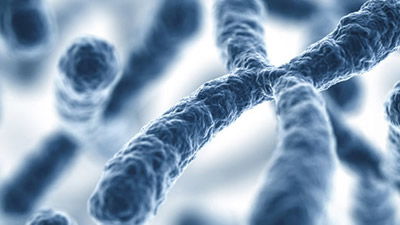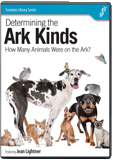
Feedback: What Does “Two of Every Kind” Mean?
I grew up in a church that believed two of every Animal was on Noah’s Ark. Well after being interested in your work I see that you teach God made “kinds” and there were “kinds” on the Ark too. But my main question has to do with Gen. 7:2 what does this mean in contrast that there were “two of every kind, male and female”? This is really confusing me especially after this new “kinds” stuff...
Your answer is very much appreciated! Thank you!
– E.D., Junction City, Kansas
Hello,
Thank you for contacting Answers in Genesis with your question about the animals on the Ark. I wasn’t able to find the exact wording you mentioned in any of the Bible translations I searched—“two of every kind, male and female”—but each translation had something similar to your quote. This wording simply means that there would be a total of two animals of a given unclean kind, one male and one female. While that is a straightforward answer, your question brings up an important subject that we need to address regularly. The issue of animal “kinds” is crucial to grasp when answering some of the common objections concerning Noah and the Ark. We’ve addressed the subject several times—for example, see this feedback, “Species and Kinds and the Ark.” But there is still a great deal of confusion about the terms kind and species. So let’s see if we can clear up some of the misunderstandings by defining both terms and then examining some of the reasons why the confusion exists.
Defining Our Terms
The idea that God created plants and animals according to their kind is stated repeatedly in the Bible’s first chapter (Genesis 1:11, 12, 21, 24, 25). Also, Noah was to bring every kind of land animal, bird, and creeping thing on the Ark to preserve them (Genesis 6:19–7:3). These kinds were to reproduce and fill the earth so it could be inhabited after creation and then again after the Flood (Genesis 1:22, 8:17; Isaiah 45:18).
When we talk about “kinds” on the Ark, we are referring to the original types of animal that God created.
Putting these passages together helps us figure out what is being described by this term. When we talk about “kinds” on the Ark, we are referring to the original types of animal that God created. We believe these passages also imply that no kind of animal (or plant) will ever produce offspring outside of its created kind. Many biblical creationists believe that the kind boundary is frequently at the family level of our modern taxonomy. In a helpful article on the subject, Dr. Georgia Purdom stated that a kind “represents the basic reproductive boundary of an organism. That is, the offspring of an organism is always the same kind as its parents, even though it may display considerable variation.” This variation is important so animals can fill the earth and adapt to the different environments that exist today.1 However, evolution (in a molecules-to-man sense) would be impossible since one kind of animal could never give rise to an entirely different kind.
What we see in the world around us fits well with the biblical view. Today we can find hares in the arctic, hares in the desert, and hares in other parts of the world. Although each species is a little different, enabling it to thrive in its environment, they are still all recognizable as hares and would be descended from a single pair on the Ark. The same is true for many other kinds of animals; they are found worldwide but are obviously related.
This brings up the problem of equating kinds to the modern-day word species as used in taxonomy. Merriam-Webster’s Dictionary defines species as “a category of biological classification ranking immediately below the genus or subgenus, comprising related organisms or populations potentially capable of interbreeding.”2 The ability to freely interbreed was certainly true within the Ark kinds, but may not always be the case within the same kind today.
For example, house mice (Mus musculus) live all over the world (except Antarctica). Yet when certain populations interbreed at contact zones, the male offspring are usually sterile. For this reason, the populations are recognized as different subspecies (and some authors have considered them different species).3 Despite almost identical appearance, genetic differences have arisen that affect the fertility of many of the offspring.4 This makes it clear that barriers to reproduction have occurred within some created kinds.
Often different populations derived from the same created kind are more obviously different in appearance. When horses (Equus caballus) are crossed with donkeys (Equus asinus), both male and female hybrids (mules) are usually sterile. In this example, the parent species can be readily distinguished, and it makes sense for biologists to classify them as different species. The fact that hybrids can be formed, even though many or most are infertile, lets us know they are from the same created kind.
There is no single definition of species that can be applied to all living things.
As it turns out, it is often difficult for biologists to agree on what is a distinct species. Breeding experiments are not usually conducted, so similarities and differences in appearance are an important deciding factor. Sometimes as genetic evidence becomes available it is decided to combine several species into one, or divide one species into more than one. There is no single definition of species that can be applied to all living things. In the end it is important to recognize that different species names are often applied to animals descended from the same created kind. This is largely the consequence of differences that have arisen within kinds as they have reproduced and filled the earth, adapting to many distinct environments.
Reasons for the Confusion
We’ve already looked at one of the reasons confusion exists on this topic—the original kinds were created to reproduce and fill the earth, which involved some physical and genetic changes as they adapted. Modern taxonomists are not trying to identify kinds; they use definitions that identify distinct groups within created kinds. But this isn’t the only cause for confusion. Let’s take a look at two more of these reasons.
1. Difficulties in Translation
When translating a word from one language to another, there is often not an exact match between the two languages. When translating from Hebrew, or any other language, translators must make a decision as to which word or phrase most accurately conveys the meaning of the original terms. One of the difficulties involved here is that our modern scientific taxonomy did not exist when these words were written down, so the biblical writer was not thinking in terms of Kingdom, Phylum, Class, Order, Family, Genus, and Species. Let’s take a look at a portion of the Flood narrative in Genesis to see how this affects the translation process:
And of every living thing of all flesh you shall bring two of every sort into the ark, to keep them alive with you; they shall be male and female. Of the birds after their kind, of animals after their kind, and of every creeping thing of the earth after its kind, two of every kind will come to you to keep them alive . . . to keep the species alive on the face of all the earth. (Genesis 6:19–20, 7:3, emphasis added)
The New King James Version includes three different classification terms in this passage: sort, kind, and species. The word sort in v. 19 is not translated specifically from a Hebrew word in this verse, but was added for readability’s sake, which is why it appears in italics in the NKJV. Kind was chosen to translate the Hebrew word מִין (mîn). This Hebrew term refers to “a type of entity in contrast to other entities” and every biblical usage is in the context of a taxonomic system.5 Species is an unfortunate translation of זֶרַע (zera‘). This word is regularly translated as “seed” or “descendants,” a point that is acknowledged in a textual note in the NKJV.
The wording, “to keep the species alive” (NKJV) may be more readable in English than “to keep seed alive” (KJV). Yet, this word choice ultimately confuses the issue. While the context helps the reader understand what is being taught, it becomes easy for the reader to conflate the English terms kind and species, thus giving the undiscerning reader the impression that the two terms mean the same thing. Many other translations are more helpful here using offspring instead of species in Genesis 7:3 to render zera‘.
2. Intentional Ignorance
I am sure the NKJV translators did not intend to contribute to the confusion on this matter, but the same cannot be said for the many skeptics who intentionally ignore the difference between kind and species so that they can mock God’s Word. We often hear skeptics claim that there are anywhere between 10–100 million species of plants and animals on Earth, and then ridicule the ideas that all the animal species could fit on the Ark and be taken care of by eight people. There are multiple problems with this type of attack.
Skeptics . . . mock the biblical term kind, . . . implying that it is some sort of pseudo-science, so it must be wrong.
First, these skeptics refuse to acknowledge the difference between kind and species. Instead, they assume that Noah would have needed to bring two wolves, two dingoes, two coyotes, two jackals, and so on. However, these different species can hybridize (mate with each other and produce offspring), so he really just needed to bring two of the dog kind. The same would be true with horses, donkeys, and zebras—Noah just needed two of the horse kind. Oftentimes they mock the biblical term kind, since it is not one of the modern scientific terms, implying that it is some sort of pseudo-science, so it must be wrong.
Second, the number of species cited by skeptics is vastly exaggerated. Evolutionary researchers announced in a recent article in the journal Science that the number of species of plants and animals on the planet is around five million, give or take three million.6 They state that 1.5 million have been named. So according to these researchers, the number of species on Earth could be as low as two million or as high as eight million.
Third, the number cited by skeptics is misleading in another way. The vast majority of these species are marine organisms, plants, or insects. Noah clearly did not need to bring marine animals on the Ark. He was not commanded to bring all plant species, and he may not have needed to bring insects either.7
When we understand that Noah needed to bring kinds of animals and not species, and we eliminate all of the sea creatures, plants, and possibly insects from the “millions of species,” it becomes clear that the number of animals required to be on the Ark is much lower than the skeptics claim. A detailed study in the 1990s by Dr. John Woodmorappe used “worst-case scenario” estimates to calculate that fewer than 8,000 kinds would have been on board.8
Over the past several years, some creationist researchers have been involved in extensive study of the original animal kinds, and their estimate is even lower—less than 2,000 kinds of animals that would need to be on board. Admittedly, this is only an estimate, since many of the original kinds have gone extinct and are only known today from the fossil record. Also, we do not have sufficient data regarding every type of creature on Earth today to ascertain all of the original kinds. However, we have published a helpful article explaining the criteria used by this research team to determine the created kinds.
Conclusion
While researchers will only be able to reach a “ballpark figure” in terms of the total number of animals on the Ark, we can be certain that God knew exactly how many animals to send to Noah (Genesis 6:20). We can also be sure the Lord knew precisely how large the Ark would need to be to hold the animals, food, people, and so on, and that He was perfectly capable of revealing that information to Noah. We know that God spared the lives of Noah and his family from the worldwide judgment of the Flood. Similarly, He will save eternally all people who believe on the Lord Jesus Christ (Acts 16:31)—the Son of God who died on the Cross for our sins and conquered death by rising from the dead.
Footnotes
- The variation has also been important for developing agriculturally important breeds, such as dairy cattle and beef cattle. Further, it adds interest and beauty.
- Merriam-Webster’s Collegiate Dictionary, 11th ed., s.v. “Species.” The Biology Online website is a little more specific, defining species as “an individual belonging to a group of organisms (or the entire group itself) having common characteristics and (usually) are capable of mating with one another to produce fertile offspring.”
- Don E. Wilson & DeeAnn M. Reeder, eds., Mammal Species of the World: A Taxonomic and Geographic Reference, 3rd ed. (Baltimore, MD: Johns Hopkins University Press, 2005), accessed October 30, 2013, https://www.departments.bucknell.edu/biology/resources/msw3/browse.asp?id=13001562.
- M.A. White et al., “Genetic dissection of a key reproductive barrier between nascent species of house mouse,” Genetics 189, no. 1: 289–304.
- James Swanson, Dictionary of Biblical Languages with Semantic Domains: Hebrew (Old Testament) (Oak Harbor: Logos Research Systems, Inc., 1997), § 4786.
- Mark J. Costello, Robert M. May, and Nigel E. Stork, “Can We Name Earth’s Species Before They Go Extinct?,” Science 339, no. 6118 (January 2013): 413–416.
- Insects may have survived the Flood outside of the Ark. Many have larval forms that are aquatic, and mats of floating debris may have protected others from drowning. There is no consensus among researchers about whether insects were on the Ark. Whichever view is correct, we can be sure there was sufficient room on the Ark for every creature God brought to Noah.
- John Woodmorappe, Noah’s Ark: A Feasibility Study (El Cajon, CA: Institute for Creation Research, 1996), xi.
Recommended Resources

Answers in Genesis is an apologetics ministry, dedicated to helping Christians defend their faith and proclaim the good news of Jesus Christ.
- Customer Service 800.778.3390
- © 2024 Answers in Genesis





